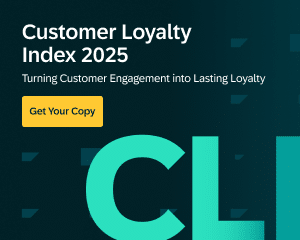Customer acquisition has never been tougher, or more expensive. Competing over the same audiences, marketers face rising media costs, inconsistent results, and mounting pressure to prove profitability. Even when you win a new customer, keeping them loyal is another battle entirely.
That’s why more brands are shifting their focus from short-term acquisition to sustainable advocacy. Instead of paying to persuade, they’re building referral ecosystems – networks of loyal customers who actively share, recommend, and grow the brand organically.
Few have mastered this better than Huel, the world’s leading complete nutrition brand. With over five million customers worldwide, Huel has turned its passionate “Hueligans” into one of its most powerful marketing channels. Partnering with Mention Me and SAP Emarsys, the brand built a referral ecosystem that drives measurable, scalable, and profitable growth, powered by customer advocacy.
In this article, we’ll explore how Huel did it: the data behind its advocacy strategy, the technology that made it possible, and the lessons you can use to build a referral ecosystem of your own.
What is a Referral Ecosystem?
A referral ecosystem is an interconnected network of advocates, referrers, and new customers who continually reinforce one another, creating a self-sustaining cycle of organic growth. It’s the next step beyond the standard “refer a friend” program.
In a healthy referral ecosystem, your customers actively promote your brand, introduce it to others, and expand your reach far beyond what paid media can achieve alone. Each new customer who joins through a referral becomes part of the same ecosystem, with the potential to refer others in turn.
Unlike traditional referral programs that rely on one-off incentives, a referral ecosystem is built on three foundations:
- Visibility: You can identify, track, and measure who’s referring and who’s being referred.
- Activation: You make it easy, and rewarding, for customers to share your brand in ways that feel natural.
- Integration: You connect advocacy data across CRM, email, and paid channels, ensuring it influences how you segment, target, and reward customers.
For most brands, this data-driven view of advocacy is still a blind spot. Word of mouth remains one of the most valuable marketing channels, but also one of the least visible. A true referral ecosystem changes that, transforming advocacy into a measurable growth engine that compounds over time.
Why Advocacy Beats Acquisition
With rising paid ad and product costs, relying solely on paid acquisition is like building a house on shifting sand. Costs fluctuate, algorithms change, and competition for attention grows fiercer by the day. You might win clicks, but sustainable growth, especially profitable growth, remains elusive.
That’s where advocacy changes the game. When customers come through trusted recommendations, they convert faster, stay longer, and spend more. They’re also far more likely to refer others, creating a compounding effect that traditional paid channels can’t replicate.
Partners like Mention Me help brands measure this value through a new lens called Extended Customer Revenue (ECR)—the combination of a customer’s lifetime value plus all the revenue they’ve generated through referrals. It’s a powerful way to uncover the true worth of your advocates.
How Huel Built Its Referral Ecosystem
So, how does a brand actually put advocacy into motion and, more importantly, make it measurable? That’s where Huel’s story becomes so valuable. With a loyal customer base already in place, the challenge wasn’t finding advocates, but activating them. By combining Emarsys’ CRM intelligence with Mention Me’s referral technology, Huel turned passive loyalty into a fully functioning referral ecosystem – one that now fuels a growing share of its revenue.
Step 1: Activate organic advocacy
Huel’s brand was already built on strong community foundations. Its customers, affectionately known as Hueligans, proudly shared their experiences online—some even went as far as getting Huel tattoos. Word of mouth was already happening; what the team needed was a way to track and amplify it.
That’s where the partnership with Mention Me began. Using Mention Me’s technology, Huel introduced seamless sharing experiences like Name Share, which lets customers tell their friends, “Just use my name at checkout.” No links. No codes. Just effortless advocacy that fits naturally into real conversations.
The results spoke volumes. In the first year, 10% of new customers came through referrals. Over time, that number more than doubled, with 22% of customers actively referring others. Huel’s next goal? To push that even further, to 27% of new customers through referrals—making it one of the brand’s largest growth channels.
“Although loyalty is great, taking that to the next level and activating customers to become brand advocates is key to growth.”
Step 2: Layer advocacy data into CRM
Huel’s next step was integrating advocacy insights into its SAP Emarsys CRM. By combining advocacy data from Mention Me with behavioral data from Emarsys, Huel gained a holistic view of each customer’s value, measured not just by spend, but by their advocacy impact.
This new perspective revealed a surprising truth: top advocates weren’t always top spenders. Some lower-spend customers were quietly driving significant indirect revenue by referring friends who went on to become loyal buyers.
Armed with this insight, Huel reshaped its segmentation strategy. Instead of focusing only on high-spend customers, the brand started prioritizing high-ECR advocates—a group that was previously invisible in its CRM.
Step 3: Reward and amplify advocates
With these segments identified, Huel began treating advocates as everyday influencers. When launching its Ready-to-Drink Black Edition, the team selected a cohort of high-ECR customers most likely to purchase and refer the new product. They received beautifully packaged gifting boxes—no strings attached, just a thank-you.
The results went far beyond sales:
By nurturing advocates with recognition and exclusivity, not discounts, Huel strengthened its referral flywheel and deepened emotional loyalty in the process.
Step 4: Use advocacy data across channels
Today, Huel uses advocacy data not just for segmentation but across every major channel. In SAP Emarsys, they build journeys that nurture advocates differently, celebrating, rewarding, and re-engaging them before they lapse.
They’re also using top-advocate profiles to create lookalike audiences for paid campaigns, helping to lower cost per acquisition by up to 25% and improve ROAS by 30%. Each insight feeds the next, turning advocacy into a full-funnel growth driver.
Lessons for Building Your Own Referral Ecosystem
Huel’s success didn’t come from a single campaign. It came from building the right systems, mindset, and measurement around advocacy. So, whether you’re a scaling D2C brand or an established retailer, here are five lessons you can apply to create your own referral ecosystem:
- Identify your advocates early: Don’t wait for referrals to happen by accident. Use your CRM and advocacy tools to pinpoint who’s already recommending your brand and what drives them to do it. Early identification lets you nurture these customers intentionally and measure their impact over time.
- Make referrals seamless: Simplicity fuels participation. Huel’s “Name Share” functionality worked because it mimicked real-life word of mouth. No clunky links or codes. Reduce friction, and you’ll see referral activity rise.
- Reward meaningfully: Recognition and exclusivity outperform discounts. Free product drops, early access, or public acknowledgment can make advocates feel valued without eroding your margins. The key is to show genuine appreciation, not transactional incentives.
- Integrate advocacy data across your stack: Don’t silo referral insights. Feed advocacy data into your CRM, email, and paid media platforms so it informs segmentation, personalization, and lookalike targeting. This turns advocacy into a performance lever across your entire marketing mix.
- Measure extended value, not just spend: Traditional lifetime value (LTV) misses the ripple effect of word of mouth. Measuring Extended Customer Revenue (ECR) gives you a truer picture of customer impact and helps prioritize advocates who quietly drive the biggest returns.
Building a referral ecosystem takes time, but the payoff is lasting. Once in motion, it compounds, and each new advocate helps you acquire more high-quality customers while reducing your dependence on paid channels.
Conclusion: Create a Connected Referral Ecosystem with SAP Emarsys
Loyalty programs create satisfied customers. Referral ecosystems create growth engines.
Huel’s story proves that when you give your happiest customers the tools, data, and recognition to advocate for you, they’ll become one of your most powerful marketing channels—one that’s organic, cost-efficient, and self-sustaining.
With SAP Emarsys and Mention Me, you can connect advocacy and automation to build your own referral ecosystem. From identifying your top advocates to personalizing their journeys and optimizing acquisition with lookalike audiences, Emarsys brings every piece together into one coordinated strategy.
If you’re ready to turn your loyal customers into active advocates, now’s the time to start.
👉 Book a demo to see how SAP Emarsys and Mention Me can help you unlock advocacy-driven growth.







